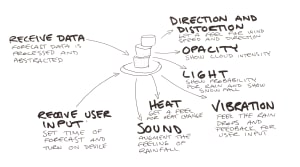
Show and tell it with physics
Today was show and tell with dataPhys. Some groups showed really nice concepts but a lot of us missed the opportunity to do some real physicalizations. In my opinion, most of us just did visualizations in a 3d space. I know the lines are blurry but we could have used physicality more, and this applies for most groups.
I think Julia, Therese and Victor did a really nice concept where visuals didn't matter that much. The data was conveyed with weight, and the "data points" where of different shapes so it would be hard to just see which was bigger or smaller. I think this was a brilliant move because it "traps" the data in physical space. An image of this physicalization communicates very little of the data. You really have to interact with and relate to the object to "read" it.
I wasn't that happy with our concept. It wasn't very strong. I don't mind that we took the provocation very literally, that was our intention and I think it was a bit fun not to make a social commentary but we could have worked a lot more on the physicality of it. It's mostly an object that you observe and very few of the data points could not just have been visualized.
Other things that came up during this course was how showing data is not neutral just because the data is just numbers. When you edit and filter data you have to think of the social and cultural context you act within.
Context and history matters
I also think there was a weird discussion about how the texts were too old to be relevant. I think it is very dangerous to think that visualization design is a solved problem in the last 10 years. We have more or less visualized data as long as we have recorded history and there are a lot to learn from that. Design is not bad just because it does not fit our current trend, it might actually be better att communicating the data. And just because we have better looking AR now than in the 90s it does not mean we have better AR.
Context and history matters, a lot.


